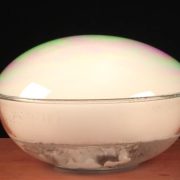Really cool demos – with dry ice
 Assuming you have your dry ice by now, let’s get into our first demonstration.
Assuming you have your dry ice by now, let’s get into our first demonstration.
Remember, wear your safety glasses and gloves. Do not ever put dry ice in your mouth. It will burn!!
Using a pair of kitchen tongs, grab a chunk of dry ice (listen to the screeching sound when the metal touches the ice) and place it on a dish. On another dish, place an ordinary ice cube. Then ask the kids which one will melt first. Fairly basic stuff, but the kids will learn that the ice cube will turn from a solid into a liquid, while the dry ice will disappear completely. It is important for students to understand that dry ice doesn’t obey the same laws of nature.
The most famous thing you can do with dry ice is to drop it in water. Something I learned from a special effects artist was to fill a metal drum half full with water, drop some dry ice into it to produce “smoke” “steam” or “water vapor”. The warmer the water, the more water vapor it made. Turning on a fan blew all of that water vapor out.
For your own experiment, start with warm water for great bubbles and water vapor. I like to use a beaker because I have no fear that it will crack, so find a container that is not going to break. A Pyrex mixing container would be ideal.
Remember, you don’t want there to be any possibility that a child can touch the dry ice, so keep the container away from them.
I have found a plastic graduated cylinder that scientists use. I half fill this with water, add a couple of drops of food coloring, drop a chunk of dry ice into it, and watch the bubbling action. Sometimes I like to take some of those light sticks, break them up and drop into the container.
These are ideas to add to your bag of tricks that are a little different from what other people do.
Take a long cylinder, or a bigger container, add a squirt of liquid soap and almost instantaneously, the bubbles will rise. But instead of seeing water vapor, all that steam is trapped inside the bubbles. It is fun to reach up and touch the bubbles as they emerge from the container, because when you pop them, all that steam emerges from the bubbles. It is almost impossible, especially with young children, to keep them from coming forward to touch the bubbles. It is a great way to occupy the kids for hours. This is your secret weapon!
If you are a middle school teacher, there are other ways to produce different color effects, like using cabbage juice.
I even thought it would be great to use dry ice to produce clouds at our wedding. My wife always reminds me on our wedding anniversary of the incredible special effects, like filling the room with “steam” and having our guests coughing and spluttering, when a whole 30lb of dry ice was dropped into a 55 gallon drum of warm water, just as we completed our vows. I do! I do! Then Cloud Nine!
Happy Halloween everyone! And stay safe!

Listen to my podcast where I share some of my favorite dry ice demos
(File size is 3.6 MB) (Show length 15 minutes 23 seconds)





Thank you dude you helped me a lot with my science fair
Dear Steve Spangler,
I am an eighth grade students doing a science experiment which will be presented through my school’s science fair. My hypothesis is: Why does dry ice keep foods frozen longer that ordinary ice cubes? I cannot find a lot of information of this, so I was wondering if you would be able to help me find answers to my hypothesis because it seems like you know a lot about dry ice. If you are able to send me some information before Ferbruary 5th,I would truly appresiate it. Please email me at [email protected]
Tehila Wiener
Tehila — Thanks for your question. I think you’ve picked a great science fair topic. As you know, dry ice is -110 degree F or -78.5 degrees C, so temperature is one reason why dry ice is a better choice. The other obvious reason is that dry ice sublimates – that is, it turns from a solid into a gas. No liquid = no mess!
I must admit that I don’t know nearly as much about dry ice as others do on the internet. I found you a few resources that might help.
http://waltonfeed.com/self/upack/dryice.html
http://www.dryiceinfo.com/science.htm
Both site have lots of great information. Please send us information about your science project when you’re finished and we’ll post it on the blog.
Thanks for your awesome website page!!! I got an A on my experiment!!!
Thank you Star. Congrats on the A.
thanks for your website! i got an a. on my science ptoject because of u! your awsome.
Hi Sarah,
Thanks for your comment and congratulations on your project!
Steve
Cool!
another thing you can do is put cold water in freezer till it is very cold put in dry ice and it gets covered in ice and you have cracks and pops and ice on the surface though if it freezes over it goes boooooooom
you are the best dry ice …. person i guess lol …PICKLES!
i did the light stick experiment and i rocked thanks for all the help
*–maddi
Cool and soo awesome!!!!
Continue the cool work people.